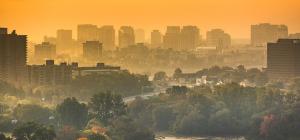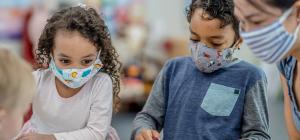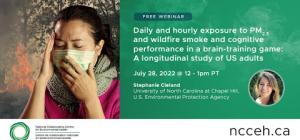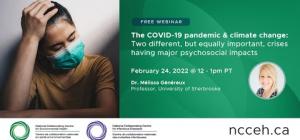
Make our communities healthier with better air quality during and post-pandemic: CANUE

The abrupt change in our lives brought about by the COVID-19 pandemic is and will continue to affect us all deeply. There are obvious changes of limited movement and social interaction with many more hours indoors. While we adopt public health measures such as physical distancing, we are all also likely missing our physical communities within cities, suburbs or small towns. As the COVID-19 situation evolves we too need to adapt to the “new normal”. This can be a reflective moment to consider our communities and how they are designed.
In Canada, over 80% of people now live in cities and this percentage tends be increasing worldwide. Urban density comes with interactions and sharing between individuals in complex ways. It also offers tremendous opportunities to optimize and enhance our individual as well as population health and wellbeing.
With COVID-19 the recognition of public health knowledge has perhaps never been greater. The Canadian Urban Environmental Health Research Consortium (CANUE) is part of the Dalla Lana School of Public Health at the University of Toronto, and is funded by the Canadian Institutes for Health Research (CIHR). CANUE is a national consortium involving researchers from multiple institutions, academic and government, with active links to a range of partners, such as the Canadian Institute of Planners, large research cohorts, including CHILD and CanPATH, Health Canada and the NCCEH. Our experts are interested broadly in environmental health and in enabling the inclusion of health in urban planning for communities. Our expertise spans six domains:
- Air quality
- Noise
- Greenness or green/blue spaces
- Climate and extreme weather
- Transportation and neighbourhood factors (such as local walkability)
- Food environments and socioeconomic conditions.
This article briefly focuses on one of these six domains: air quality. Despite our relatively clean air in Canada, air quality continues to pose risks particularly as a consequence of our congested cities. Traffic air pollution affects us all; one-third of Canadians live within 250 metres of a major road and are thus exposed to traffic emissions and these exposures are linked to a range of adverse health outcomes from early life allergic sensitization to atherosclerosis to dementia . Planning our future cities and transportation infrastructure clearly need to address the multi-faceted impacts of too much traffic, from lost time and productivity to stress of gridlock to noise to the air we breathe. CANUE’s data on multiple air pollutants, mainly NO2, PM2.5 and O3, and our transportation working group are available to help guide research on impacts and solutions.
Cleaner air is arguably one bright spot of our current COVID-19 situation. Satellite images have revealed dramatic reductions in urban NO2 worldwide as traffic have greatly diminished, including recent images prepared by CANUE members at the University of Montreal. At the Southern Ontario Centre for Atmospheric Aerosol Research, also a key partner of CANUE, the ground monitoring data of traffic counts and air pollutants are being assessed day-by-day. These offer a more-quantitative glimpse of how the air is improving at key locations in Toronto, which is by about 50%, complementing what are currently more-qualitative changes seen from space. However, the role of changes in weather and data availability must be considered in both cases. Satellite air pollutant measurements, have advanced understanding of air pollution and its global impacts tremendously and are key source of CANUE’s national data holdings, particularly the PM2.5 exposure estimates developed at Dalhousie University.
The advantage of a one-stop, up-to-date, comprehensive environmental data platform is even revealing itself in today’s fight against COVID-19. Readily available data through CANUE has rapidly gotten to the hands of multiple researchers, including at Health Canada and the U of Toronto, working to verify reports that air pollution is contributing to more COVID-19 cases the U.S. While immediate priorities of dealing with this pandemic need to be elsewhere, if air pollution is contributing to greater susceptibility this could be important to know down the road in minimizing outbreaks and/or protecting individuals. As Dr. Sarah Henderson pointed out in the last NCCEH blog there are multiple reasons to expect that forest fire smoke and COVID-19 are an even worse combination.
We long to enjoy our vibrant community life as soon possible. Let’s all aim to make it even better than before. With the renaissance in the quantity, quality and availability of environmental data, of which CANUE is at the forefront, we have the technology. Happy 50th Earth Day!
About the author:
Dr. Jeff Brook is CANUE’s Scientific Director and an Assistant Professor at University of Toronto. He was previously a senior research scientist in the Air Quality Research Division at Environment and Climate Change Canada. CANUE’s main goal is to increase scientific understanding of the interactions among the physical features of the urban environment, individually and in combination, their effect on health and how they can be modified to improve health. Follow CANUE on Twitter: @CANUEConsortium.
(Photo by Alexander Popov on Unsplash)







